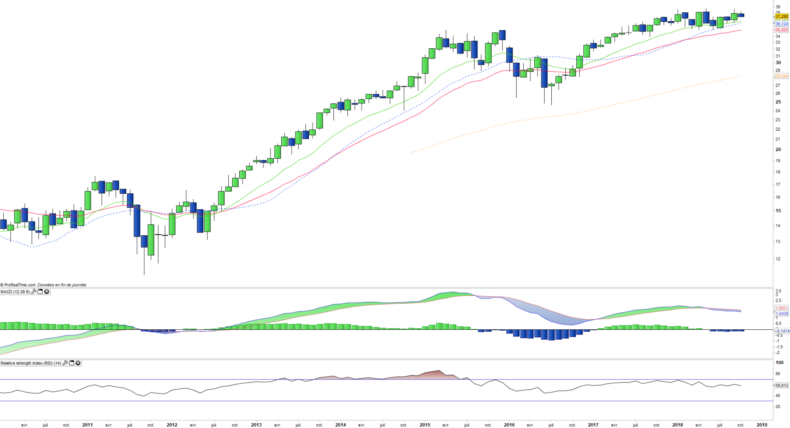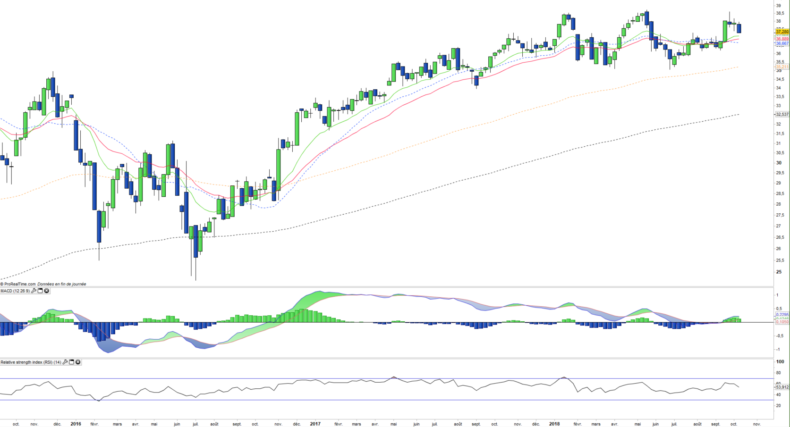Lyxor ETF Insurance - INS - 11/10/2018
Short Term strategy: Positive (80%) / Trend -
Long Term strategy: Positive (90%) / Trend =
Characteristics of the ETF
The Lyxor INS ETF (UCITS), created in 08/2006 is listed in Euro on Euronext and replicates the Stoxx 600 Europe Insurance NR index which is composed of the 33 main European insurance values. It should be noted that stocks outside the euro zone represent 47% of the index, which is not insignificant given the potentially significant fluctuations of the £ and CHF against the Euro.
The cost of this ETF is 0.3% and the AUM is approximately € 68m, against € 646m for BNK, which replicates the European banking sector. The replication method is indirect (via a swap) and the distribution method is capitalized.
Alternative ETFs: SYI (BNP Theam in Euro), EXH5 (iShares in Euro),
Latest developments
The index returned to growth in 2017 (+ 11.1%) and rose by 2.9% for the time being in 2018, a clear outperformance compared to the stoxx600NR index (-3.3%).
The sector currently behave as a safe haven in a period of correction of growth stocks and reflation of the economy, which should lead to a normalization of monetary policy that will benefit the sector, which is highly exposed to interest rates especially for life insurance or fund management.
Significant productivity gains have been achieved in recent years, particularly in terms of digitization and restructuring. The sector is cheap and is valued about 10x s 12M forward earning , which is much lower than the Stoxx600 (14x) while the average yield is high and fairly secure, at around 5% which represents a solid support for investors.
Index & components
The stocks in this index are mainly British (23%), German (24%), Swiss (17%) and French (12%).
The top 10 stocks of the index represent c.70% of the weighting, among which we find giants like Allianz, Axa, Prudential or Zurich Insurance Group.
About 53% of companies in the index are listed in Euro, the other part mainly in Pounds Sterling and Swiss Francs.
The insurance sector is largely influenced by the macroeconomic environment that directly conditions demand, except for the insurance-damage component, which depends on statistical and exogenous factors. More specifically, interest rates are the main factor of performance because they make insurance products (including life insurance) more or less attractive. They also largely determine profitability because insurers, as long-term savers, invest premiums primarily in bonds. In recent years, low interest rates imply a contraction in spreads that negatively impacts profits. However, only new premiums are invested at lower returns, and insurers can rely on higher rate levels from previous years that allow for some smoothing.
When investment returns are falling, insurers clearly need to improve their bottom line and portfolio management becomes the engine of performance. The quest for return requires a gradual return to risky assets or alternative investments. It also implies that geographic exposure has a strong impact on sales depending on the country's macroeconomic environment and also on the balance sheet because insurers tend to invest their assets in the same area as their liabilities.
The rise in the sector remains a bet on the rise in long-term interest rates, which seems well underway in the United Kingdom while the euro zone should follow thereafter, while the ECB is just starting to give the first signals of future normalization of its monetary policy, with a view to a gradual reflation of the European economy.
Monthly data
The monthly chart shows a well-established uptrend despite the severe disruption in 2016. The index is currently undisturbed by market volatility and merely pauses, with a contraction in the dynamics of the main oscillators but with moving averages that remain ascending. The relative performance of INS is impressive.
Weekly data
On the weekly chart, we can observe a stabilization of the medium-term technical situation in the form of a trading range between € 35 and € 39, with an index that remains above short term moving average and an EMA100 always upward. The technical indicators are positively oriented, which makes INS an interesting fallback solution in a context of a market correction.
ETF Objective
INS is a UCITS ETF, listed in EUR, which seeks to replicate the STOXX Europe 600 Insurance Net Return EUR (34 european companies)
Characteristics
| Inception date | 18/08/2006 |
| Expense ratio | 0,30% |
| Issuer | Lyxor |
| Benchmark | stoxx 600 Insurance net return |
| ticker | INS |
| ISIN | FR0010344903 |
| UCITS | Yes |
| EU-SD Status | Out if scope |
| Currency | € |
| Exchange | Euronext Paris |
| Assets Under Management | 69 M€ |
| Dividend | Capitalization |
| PEA | Yes |
| SRD | Yes |
| Currency risk | Yes |
| Number of Holdings | 34 |
| Risk | 3/5 |
Country Breakdown
| Germany | 24% |
| United Kingdom | 23% |
| Switzerland | 18% |
| France | 12% |
| Netherlands | 6% |
| Italy | 5% |
| Others | 12% |
Sector Breakdown
| Financials | 100% |
Top Ten Holdings
| Allianz | 17% |
| Prudential | 10% |
| AXA | 10% |
| Zurich Ins. Group | 8% |
| Muenchener Rueckver | 6% |
| Swiss Re | 5% |
| Aviva | 4% |
| Sampo OYJ | 4% |
| Assicurazioni Generali | 4% |
| Legal and General Group | 4% |


